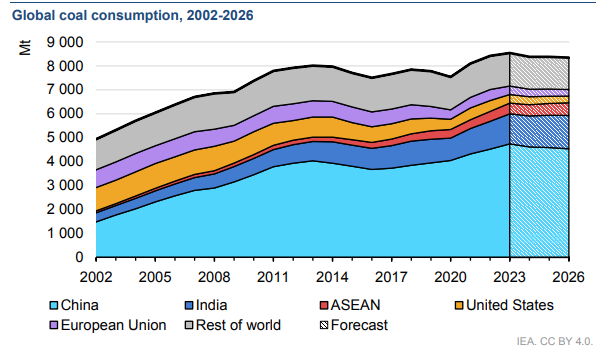Global Coal Demand Record 2023

The Coal 2023 Report of the International Energy Agency
– The growth in consumption in India (+8%) and China (+5%) drives global demand for coal to the new record. In 2023, the International Energy Agency (IEA) is predicting a global increase of 1.4%. In absolute terms, the threshold of 8.5 billion tonnes will be exceeded for the first time.
After peak, -2.6% in 3 years for global demand for coal
Nevertheless, over the next 3 years, the IEA’s Coal 2023 Report estimates that global demand for coal will begin to decline, reaching -2.6% in 2026 compared to this year’s volumes. It is the first time that the agency led by Fatih Birol foresees a bending of the curve. The reasons? The downturn will occur even without more ambitious climate policies than the current ones: the renewable installed capacity expected in the next three years will suffice.
Beijing’s shadow on global coal trajectory

And it is above all what happens in China that will determine the trajectory of global demand for coal. Beijing is the largest consumer of the most polluting fossil source, which alone in 2022 covered more than 56% of the country’s total energy consumption. Half of world demand is linked to the Asian country. And in China is concentrated most (70%) of the projects of new coal power plants in the world: between plants under construction, in the (pre-)permitting phase or only announced, the pipeline is now over 550 GW long.
But Beijing itself is driving the global expansion of renewable capacity. By balancing new wind and photovoltaic plants with the expected use of coal, the IEA expects China’s coal demand to decrease in 2024 and stabilize until 2026. However, there is no certainty about the trend in the medium and long term: “Prospects for coal in China will be significantly affected in the coming years by the pace of clean energy deployment, weather conditions and structural changes in the Chinese economy,” the report said.
A structural transformation
Despite the expected decline, the decrease in global demand for coal will not be fast enough to meet a trajectory compatible with the Paris Agreement. By 2026, it will still be above 8 billion t per year. But unlike other situations – the implosion of the Soviet Union, the pandemic – in which coal has fallen only temporarily, this time there are premises for a structural change. “A turning point for coal is clearly on the horizon, although the pace at which renewable energy will expand in major Asian economies will determine what happens next, and much greater efforts are needed to achieve international climate goals,” comments Keisuke Sadamori of the IEA.





